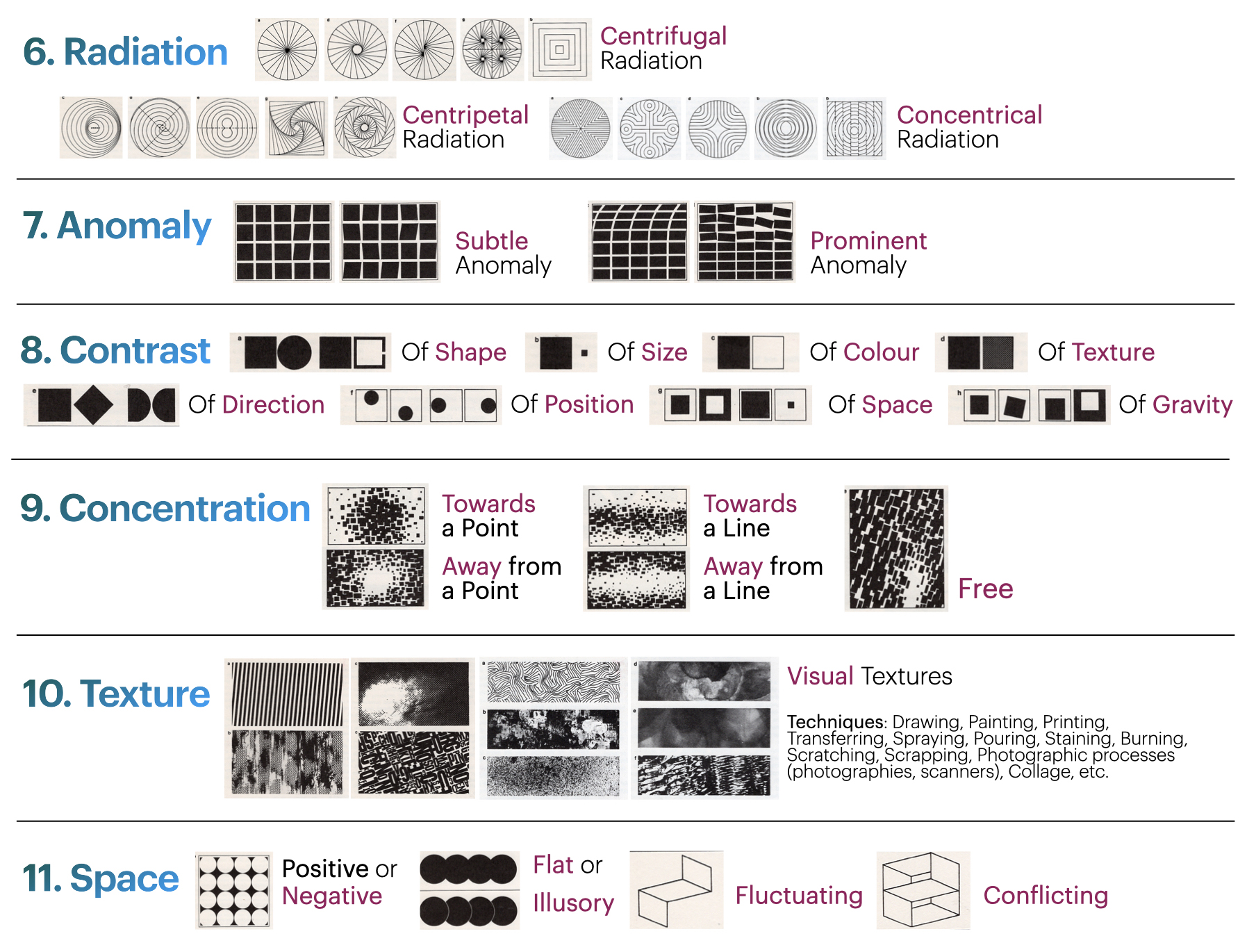MediaArtTutorials
Composition Techniques I – Part 2

Objective
Create three digital compositions that explore the Interrelationships of Form:
- Union
- Subtraction
- Intersection

In each composition should incorporate Wucius Wong’s Principles of Two-Dimensional Design—Radiation, Anomaly, Contrast, Concentration, Texture—to explore and highlight the visual characteristics of each interrelationship.
Create one digital composition that incorporate Wucius Wong’s Principles of Two-Dimensional Design: Space
Each composition must demonstrate a thoughtful and cohesive integration of form relationships and design principles.

Design Restrictions
- Use geometric, organic, or accidental shapes
- Designs must be in black and white
- You must incorporate a grid structure only for Composition 1 and Composition 2 (choose one per composition from the following):

Software:
- Adobe Illustrator (vector-based composition)
- Adobe Photoshop (texture/image-based processing only)
Activities
Complete the following activities in order. Ask your professor for help if needed.
[15–20 min] Sketching
Sketch using either a digital or physical notebook.
A sketch is “a rapidly executed freehand drawing that is not usually intended as a finished work.”
Composition No. 1 – Union + Anomaly
- Sketch a Super-Unit based on the Union interrelationship of form.
- Choose one grid structure from the list under Design Restrictions.
- Repeat your Super-Unit within the grid to create a composition that emphasizes Anomaly using variation or disruption in form, scale, or placement.
Composition No. 2 – Subtraction + Concentration & Texture
- Sketch a Super-Unit using the Subtraction interrelationship of form.
- Choose one grid structure from the list under Design Restrictions.
- Create a composition that emphasizes Concentration and Texture.
- Describe the type of texture you will use: photography, pattern, letterforms, etc.
- Texture must be in black and white and will be applied inside the Super-Unit.
Composition No. 3 – Intersection + Contrast & Texture
- Sketch a Super-Unit using the Intersection interrelationship of form.
- Create a free-grid composition using the Super-Unit.
- Emphasize both Contrast and Texture in your design
Composition No. 4 – Spatial Line Drawing
Using only lines, sketch a composition inspired by one of the following Wong’s Principles of Space:
-
Flat Space,

-
Illusory Space, or

-
or Fluctuating and Conflicting Space

[1h–1h30m] Executing in Adobe Illustrator & Photoshop
Document Setup (Required)
⚠️ You must follow the tutorial and file setup instructions exactly to avoid losing points.
Skipping or incorrectly completing this step will affect your grade.
Before you begin, watch the provided tutorial on Illustrator document setup. Follow it step-by-step to create one separate file per composition.
Your Illustrator document must include the following settings:
- Units: Pixels
- Size: 1000 × 1000 px (1:1 aspect ratio)
- Bleed: 10 px (on all sides)
- Color Mode: RGB
- Raster Effects: High (300 PPI)
- Naming Protocol:
Lastname-Firstname-CompTech1-#.ai– starting with number 5.
These settings ensure your file is compatible with export and review processes. Files that do not follow the setup guidelines may be marked down.
Build Your Compositions
More tools and behaviours in Adobe Illustrator
Create Your Grids (Compositions 1 & 2 only)
- Use your sketched grids as a reference when recreating them in Adobe Illustrator.
- Place all grid elements in the “Grid” or “Guides” layer to keep your file organized and editable.
- ⚠️ Grids must be properly structured to support your final composition. Watch this tutorial to learn how to properly set up your grids in Illustrator:
Make sure to match the grid style (Inactive, Active, Visible, or Repetition-based) that you selected during your sketching phase.
Create Your Super-Units (Compositions 1, 2 & 3)
- Use your sketches as guides.
- Follow the tutorial on visualizing Interrelationships of Form in Illustrator.
- Place the main shapes in the “Composition” layer.
- Don’t forget to embed all linked images on Adobe Illustrator.
Download & Prepare Textures (Compositions 2 & 3)
Textures must be in black and white, minimum 800px on their shortest side.
Build Your Final Compositions
- Follow your sketches closely.
- Integrate the appropriate Interrelationship of Form and Design Principles into each layout.
- (For Composition 4 only) – Use the Curvature Tool and Pen Tool in Illustrator.
- Don’t forget to embed all linked images on Adobe Illustrator.
📥 Final Submission
- A single PDF file containing your sketches for all four compositions
- Naming:
Lastname-Firstname-CompTech1-Sketches2.pdf
- Naming:
- Four separate PDF files, one for each final composition
- Naming:
Lastname-Firstname-CompTech1-5.pdfLastname-Firstname-CompTech1-6.pdfLastname-Firstname-CompTech1-7.pdfLastname-Firstname-CompTech1-8.pdf
- Naming:
📌 Failure to follow document setup or naming instructions may result in a grade deduction.